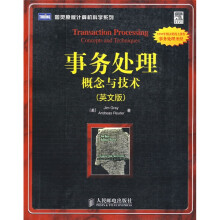PART ONE -The Basics of Transaction Processing
1 INTRODUCTION
1.1 Historical Perspective
1.2 What ls a Transaction Processing System?
1.2.1 The End Users View of a Transaction Processing System
1.2.2 The Administrator/Operators View of a TP System
1.2.3 Application Designers View of a TP System
1.2.4 The Resource Managers View of a TP System
1.2.5 TP System Core Services
1.3 A Transaction Processing System Feature List
1.3.1 Application Development Features
1.3.2 Repository Features
1.3.3 TP Monitor Features
1.3.4 Data Communications Features
1.3.5 Database Features
1.3.6 Operations Features
1.3.7 Education and Testing Features
1.3.8 Feature Summary
1.4 Summary
1.5 Historical Notes
Exercises
Answers
2 BASIC COMPUTER SCIENCE TERMINOLOGY
2.1 Introduction
2.1.1 Units
2.2 Basic Hardware
2.2.1 Memories
2.2.2 Processors
2.2.3 Communications Hardware
2.2.4 Hardware Architectures
2.3 Basic Software---Address Spaces, Processes, Sessions
2.3.1 Address Spaces
2.3.2 Processes, Protection Domains, and Threads
2.3.3 Messages and Sessions
2.4 Generic System Issues
2.4.1 Clients and Servers
2.4.2 Naming
2.4.3 Authentication
2.4.4 Authorization
2.4.5 Scheduling and Performance
2.4.6 Summary
2.5 Files
2.5.1 File Operations
2.5.2 File Organizations
2.5.3 Distributed Files
2.5.4 SQL
2.6 Software Performance
2.7 Transaction Processing Standards
2.7.1 Portability versus Interoperability Standards
2.7.2 APIs and FAPs
2.7.3 LU6.2, a de facto Standard
2.7.4 OSI-TP with X/Open DTP, a de jure Standard
2.8 Summary
Exercises
Answers
PART TWO The Basics of Fault Tolerance
3 FAULT TOLERANCE
3.1 Intreduction
3.1.1 A Crash Course in Simple Probability
3.1.2 An External View of Fault Tolerance
……
PART THREE-Transaction-Oriented Comprting
PART FOUR-concurrency Control
PART FIVE-Recovery
PART SIX-Transaxtional File System:ASample Resource Manager
PART SEVEN-System Surveys
PART EIGHT-Addenda
INDEX

 缺书网
缺书网 扫码进群
扫码进群




